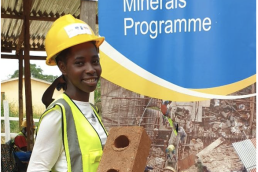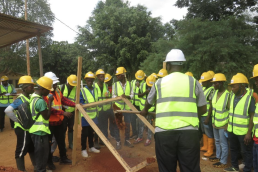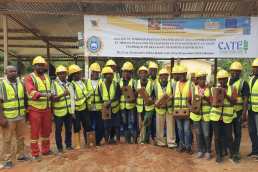Belabo, a town nestled in the East Region of Cameroon – known as the region of the rising sun – is endowed with lush green landscapes and is rich in natural resources. Despite the bounty of nature, much of its population remains impoverished and lacks basic necessities. More than 60 percent of people living here lack access to decent housing and reliable electricity.
These challenges are also faced by government offices, businesses, and schools. The classrooms at the Government Technical High School of Belabo overflow with students, the office space is cramped and much of the infrastructure is in need of repair.
To remedy the situation at the school, the administration came up with a plan to rebuild and expand using local materials for construction. With the aim of limiting emissions, the school set up an incubator that trained students on the use of local materials for construction and installed an earth brick press a few years ago. However, that initiative lay dormant due to the lack of expertise.
In November 2024, entrepreneurs, artisans, and students in Belabo set out on a journey to transform their communities and their future.
The school hosted an innovative workshop on low-carbon construction, organized by the ACP-EU Development Minerals Programme, implemented by UNDP. The aim of the workshop was to tackle two critical challenges faced by communities across Cameroon: decent housing and reliable electricity, training participants how to build solar housing with eco-bricks. The training focused on reconstruction of housing and infrastructure using local resources to improve the lives of local populations.
The Call for Change
The school’s experiment to use stabilized earth bricks made it a perfect venue for the workshop. It provided an opportunity to rejuvenate the dormant clay brick incubator, while teaching participants to build eco-friendly buildings and reduce reliance on high-carbon materials. The 68 participants – 24 of whom were women – were trained in the art and science of sustainable construction.
This training by the ACP-EU Development Minerals Programme revived the incubator and the brick press that is now being used to make compressed and stabilized bricks. It introduced the idea of harnessing soil and sunlight to produce sustainable construction materials.
A Community Effort – Building Together
The workshop was organized with the support of partners like the Ministry of Mines, Industry, and Technological Development, University of Dschang, SolarHouse, and the Institute of Fine Arts in Foumban
Instructor Dr. Njoya trained participants in the science of soil stabilization, while Robert Sandjong inspired them with innovative techniques in brickmaking.
Dr. Moussa Charlot, the Programme’s national coordinator from UNDP, stressed the significance of the work: “This is about more than construction. It’s about equipping communities to drive economic growth while caring for our planet.”
A Comprehensive Training Program
Over the course of two weeks, participants gained theoretical knowledge and hands-on training in:
- Soil Selection and Stabilization: Learning to test soil types for suitability in making compressed earth bricks.
- Compressed Earth Bricks (CEBs) Production Techniques: Using manual brick making machines, they learned how to use the right balance of soil, water, and stabilizers to produce strong and durable bricks using locally available laterite and clay soil.
- Energy-Efficient Construction: Exploring the use of eco-materials to create sustainable, low-carbon buildings.
They produced over 400 bricks daily, that were used in the construction of a demonstration office. This building highlighted the potential of CEBs, and incorporated design elements inspired by local culture and traditions.
The training inspired participants to dream bigger. “This workshop trains us on how to use locally available materials to construct quality homes,” said Leticia Louksoui Menkoke.“I plan to use these skills to help others in my community.”
Participants also explored the integration of solar energy into construction, learning how to enhance energy efficiency through intelligent building designs.
“This training is helpful to everyone worldwide because it trained us on how to use our locally available cost-effective materials to solve our housing needs,” said Mbadji Mispa, a student. I plan to apply these skills by creating my own business on low-cost housing”
A Ripple Effect
The workshop also inspired local leaders in the region. Town councilors have committed to improving the capacity of the stabilized earth bricks press and raising awareness about eco-materials and creating a club of “friends for low-carbon construction”. They also pledged to integrate solar energy and intelligent building practices within their schools.
Ngandji Mbida Passy, Chief of Service and Higher Technician of Urbanization at the Belabo Council said: “This training workshop helps us valorize our locally available materials i.e., earth brick and solar energy to meet our housing and energy needs,” he said. He thanked UNDP and the European Union for their support to fight climate change and meet the needs for adequate housing and electricity, and added he would personally convince the mayor and the Belabo Council to “use of only compressed earth brick for the construction of all building walls in the Belabo Council area.”
A Legacy of Hope
Given the hands-on groundwork and the commitment of participants and municipal authorities the workshop ended on a note that despite the challenges, change is possible.
It was another step on the road to shaping a sustainable future for Cameroon, and to empower communities with the knowledge and tools to create a future where no one is left behind. Here, in this small town of Belabo, they are building dreams, one brick at a time.




